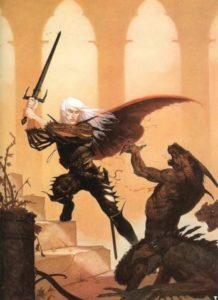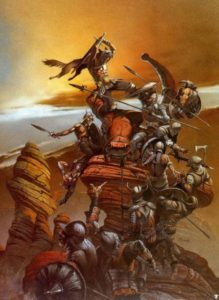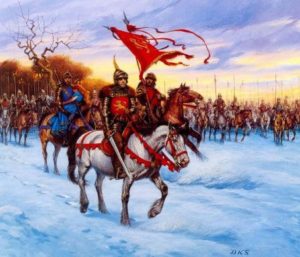 TEMPLARS DOING BATTLE TODAY
TEMPLARS DOING BATTLE TODAY
How and why do we choose the fights we fight? You may have read about a few of our modern battles in the archives of the NewTemplars discussion list at yahoogroups. We helped during the war against the Taliban in Afghanistan by taking on the enemy where it dwelt on the spiritual plane. We battled the dark forces influencing and powering the Taliban. We helped in Iraq before the US attacked by trying (in vain sadly) to reveal the hidden weapons of mass destruction and hidden terrorist camps. All of our work is done on the spiritual plane by “remote.” We frequently go up against the dark, oily, putrid forces that swirl above Israel, profaning the Temple Mount and trying to destroy the tiny nation of Israel. We also helped when a slave ship of African children went missing in 2002, and when an African country was chopping off the arms of children caught stealing diamonds.
Our Battles are often called Missions, though there is a difference. What current cause or struggle would you like to see the Templars tackle? Design a mission or at least come up with some ideas. Email your ideas to the Templar Officers with “Templar 1st Deg. Battle suggestions from ________ (your magikal name)” in the subject line.
Now for assignment two on this page, please read the WESTERN MARTIAL ARTS history below and check out all the artwork.

Demon Slayer by Gerald Brom


Click Here for more Fantasy Warriors and War Art,
both good and evil characters.
WESTERN MARTIAL ARTS: AN HISTORICAL OVERVIEW
Lady Deborah, R+C
Disclaimer from Lady Deborah, R+C, writer of the following lesson:
I am not a military maven. Although I majored in social science education (world history, U.S. history, psychology), I much prefer what I call “lifestyle history”–the history of how people lived their daily lives. So the military-minded among us might not like this overview. I am open to collaboration if someone wants to jump in on this. Email Lady Deborah or Katia, Prioress with your suggestions.
* * * * * * * *
With the influx of Eastern martial arts into the Western world after World War II, some would say that Western martial arts no longer exist. Or perhaps that they exist only in the form of weaponry, not in any sense of mental or spiritual discipline (as seen in Eastern martial arts). But Western martial arts still exist, and have recently seen a resurgence.
What is the difference between Eastern and Western martial arts? Opinions here will differ greatly. The underlying philosophy behind the development of both types of martial arts is quite different. Most Eastern philosophy is circular in nature; it returns the student to the same point. (Some would revise this slightly to say that it is spiral, revisiting a similar point on a higher plane.) Worldwide, earth-based religions share this same circular philosophical pattern. The Western world held this viewpoint for many centuries as well.
But then came the Greeks and later their imitators, the Romans. Greco-Roman thought is primarily linear and progressive. That is, Greco-Roman philosophy began to see life in terms of linear progress. This was excellent for such things as invention and the development of central government, but not so good for religion (which works better as a circular construct). Martial arts in the West took on this same linear viewpoint. So while the “barbarians” (non-Greek or Latin speakers) and those in the East maintained their circular viewpoint, the Greco-Roman world progressed to develop methods of mass warfare and weaponry at a much more rapid rate. This was due to the philosophical underpinnings that allowed for experimentation and progression.
While the Greeks, and later the Romans, were developing the systems that allowed for rapid progress (and more efficient killing!), other groups in Europe continued to train their warriors as they always had. In the warrior training schools of the Celts we find a system of personal training that is more similar to that of Eastern martial arts. The school of Scota, off the coast of Scotland, and the school of FInn McCool in Ireland are examples of the use of physical training, personal discipline, and overall personal development stressed in Celtic martial arts.
In these schools, the students passed through a rigorous schedule of general physical training (to develop stamina); training in the use of specific weapons; and spiritual training to teach the student how to use the skills he or she was learning. Finn McCool’s training included grooming and deportment, particularly dealing with the ladies (since warriors were often housed with regular folks during the winter months). The life of a soldier was not easy, and previous generations of soldiers had not helped their own reputations by their actions. McCool’s stress on understanding Celtic Law (Brehon) and improving the reputation of the soldier did much to draw new recruits and to give us an example of the mental, emotional, and spiritual discipline needed to be a true warrior.
The combination of physical, mental, and spiritual discipline stressed in these schools comprise much of the heart and soul of Western martial arts. As Western martial arts are being revived and reconstructed, these schools are providing an example of holistic training.
Unfortunately for the Celts, however, Rome was catching on to the idea of developing martial systems that would not be penetrated by the religious fervor of the Celtic warrior class. Caesar had too many men, and they were too well-trained in new techniques of group warfare, to be overcome by the often-quarreling Celts. So Rome, free from threats from her back door, proceeded to create her empire.
Eventually, however, the soldiers tired of constant travel, constant warfare, and mercenaries were hired to take the place of the loyal Roman troops. Morale suffered greatly, and the Roman Empire soon unraveled. What was left was a patchwork of warlords and landowners who tried to gather their own troops to protect their lands. The feudal system evolved out of the vacuum left by Rome’s fall. And so we come to the age of the individual knight.
Knights by themselves were impressive weapons. With the development of protective armor (evolved from Roman leather breastplates) and the use of horses in combat, it was difficult to defeat them. More powerful landowners had the services of more knights, so often the rich just got richer. Although there were schools to train knights, most were locally trained to ensure their loyalty. Contests drew knights from large distances who were looking to sharpen their skills outside of combat. These contests were later banned in many places, however, when the knights started killing each other in the process. (Not a good investment for the landowners!)
Bands of knights roaming the countryside, though, was not such a good thing. Knights attracted attention, and groups of followers. Since many young men would not inherit lands (due to the medieval focus on primogeniture, which gave everything to the eldest son), these precursors to modern gangs were becoming a nuisance. Something was needed to divert their energies.
That something was the Crusades. A chance to travel, to see the world, to gain the spoils of war, to get one’s own piece of land–many young men jumped at the chance to sign up. Much to the dismay of the leaders of the first Crusade, however, these young men were not trained. Disease, heat, and lack of training kept many from receiving an earthly reward.
The Knights Templar, and later the Hospitallers (in their military divisions), filled the need for training and discipline. It should be remembered, though, that these groups were products of their times. In other words, the only ruling force of that time was that of the Roman Catholic Church. Temporal authority, in terms of powerful kings ruling nations, were still developing. Nationalism was still some centuries off. So knightly orders took their direction from the Church. Thus some of the rules, which don’t make sense to those of us living in modern times (like sending a man to the heat of the desert encased in sheepskin underwear!) were congruent with the strictures of the Church, and therefore were not usually questioned, at least in public.
The training schools developed by the military orders hearkened back to the time of Scota and Finn McCool. The knights learned discipline not just for the battlefield, but in their spiritual and personal lives as well. But as the underpinnings of medieval life were based in Greco-Roman, linear thought, military systems evolved as well.
The Crusades taught the knights much about working in concert with others, as well as developing weapons of mass warfare. Siege engines were created, which require an army of men behind them (as well as a large supporting cast to keep the troops fed and supplied with water). These machines were later used in Europe to fight the Moors and “heretics”.
As temporal kings began to consolidate their power and subjugate smaller kingdoms under them, the bands of knights and the military orders gave way to national armies commanded by kings. Although some sense of discipline was kept, it was primarily focused on battle orders; much of the spiritual and personal discipline was lost. Western martial arts began to focus on weaponry and group tactics instead of personal discipline.
Over the centuries, as the Middle Ages gave way to the Renaissance and the Age of Discovery, military service often involved travel once again. European colonies were set up in faraway lands, then lost as the colonies rebelled against the often-exploitative colonizers. The balance of national power became important, as wars were sometimes started just to keep upstarts from gaining too much power. Warriors were used to gain and maintain power; they became part of the machinery.
It is interesting that a resurgence of interest in personal, spiritually-oriented martial arts began in the West after World War II. Although war has been a constant companion of mankind in various parts of the world since that last great conflict, large-scale war is something no one wants to repeat (particularly with the threat of nuclear weapons). As Western nations stopped drafting young people into military service, Eastern martial arts gained participants.
Concurrent with the growth of interest in Eastern martial arts, Western spirituality (such as druidry and esotericism) has also grown. Some of these groups use Eastern techniques (such as yoga and Eastern martial arts) to enhance their understanding. But within Western mysticism there is a burgeoning interest in Western martial arts. The combination of personal and spiritual discipline with Western martial techniques (swordplay as well as firearms) is an area of great interest to a variety of groups. The Order of Bards, Ovates, and Druids seems to be moving toward a reconstruction of Western martial arts; their message board occasionally features comments to that effect. The internet is becoming a gathering place for folks from various countries to discuss these matters and share resources.
The warrior’s pendulum has swung once again in favor of individual combat, unfortunately due to terrorism. The time has come for Western martial arts to revive themselves to combat such threats.
ASSIGNMENT: Copy the following questions into an email, insert your answers and send to the Templar Prioress with the subject line, Western Martial Arts from __________ (your magikal name)
1. T/F Western martial arts no longer exist.
2. What is the basic difference between Eastern and Western philosophy?
3. What types of training were used int he Celtic warrior schools?
4. The _________ _______ evolved out of the vacuum created by the fall of Rome.
5. The main ruling force of the Middle Ages was the _________ __________ _________.
6. When did a resurgence of interest in Western martial arts occur?
7. Do you think the development of Western martial arts is important today?
